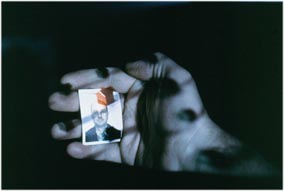The Sitting Room
Stories and experiences of HIV and AIDS

The Sitting Room was a series of performances developed between 1996 and 1999. Structured around storytelling as a common element the works developed one out of the other, each one in the series referencing the episode that preceeded it.
In 1996 I was invited by Prema Arts Centre in Gloucestershire, UK, to make a new work for World AIDS day in and took this as an opportunity to reflect upon the social impact of AIDS in the previous ten years. Since the mid 1980's I had developed a series of works that functioned as both a document and a comment upon the personal-political changes bought about by the AIDS pandemic. In particular between 1991 and 1992 I was invited by the Artists' Agency to take up a photography residency to work with people affected by HIV and AIDS in the North East of England. (see Nicholas Lowe, Michael Macmillan, Living Proof: Views of a World Living with HIV and AIDS, Artists Agency, Sunderland, UK 1992.)
For the new comission at Prema I decided to make a work that would revolve around story telling; retelling stories people had told me about their lives since HIV; remembering things that had happened to me, on the street in the bars in the parks; things that had been seen on the TV or published in the newspapers. Social issues, homophobia, pride and strength, healtcare, drug research, victim blaming, anger and loss, eating, drinking, sleeping, walking, living in a world affected by HIV and AIDS. I wanted to find a way to honour the experiences, to present what was important with frankness and dignity, to offer an audience an opportunity to see things with the honesty that these things had been given to me. If this 'new' audience was to be given entry to 'other peoples' experiences I would need to find a way to extend their understanding of themselves as viewer/particpants, to see the experiences of others as being comparable to aspects of their own lives. To see themselves as also affected by HIV and AIDS, to understand at once the ordinary, everyday and yet extraordinary qualities of existance that experiences of HIV and AIDS represent.
In pursuit of this I considered how a domestic setting would provide a structuring device that might replicate the domesticity in the situations my stories were coming from; in bed, at the kitchen sink, in the bathroom, watching TV in an easy chair, sleeping in the sun on the livingroom floor. The 'situation' I finally chose was a meal time. I began to 'imagine the conversation that might take place if I were to invite my dead friends to dinner'. Which friends would I invite, who would sit next to who, it wouldn't do to invite people who didn't get along. Some of these people had never met when they were alive. What does it mean that I call them together when they are dead? They may have nothing to talk about. Was the only thing that they might have in common a virus? I drew up list after list of guests, placed them at the table in different configurations. After some time the same names would come back again and again. Finally my guest list was set at thirteen - Mark, Terry, Hew, Andy, Dave, Adrian, Peter, Keith, David, Simon, Malcolm, Michele and Anthony.
